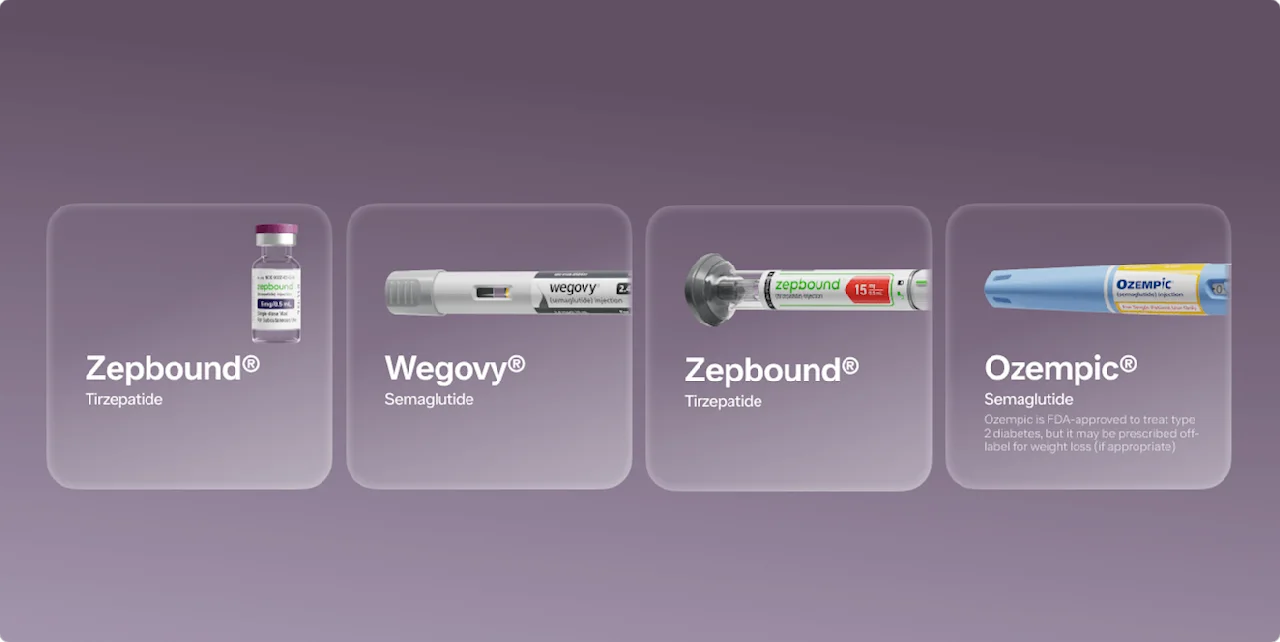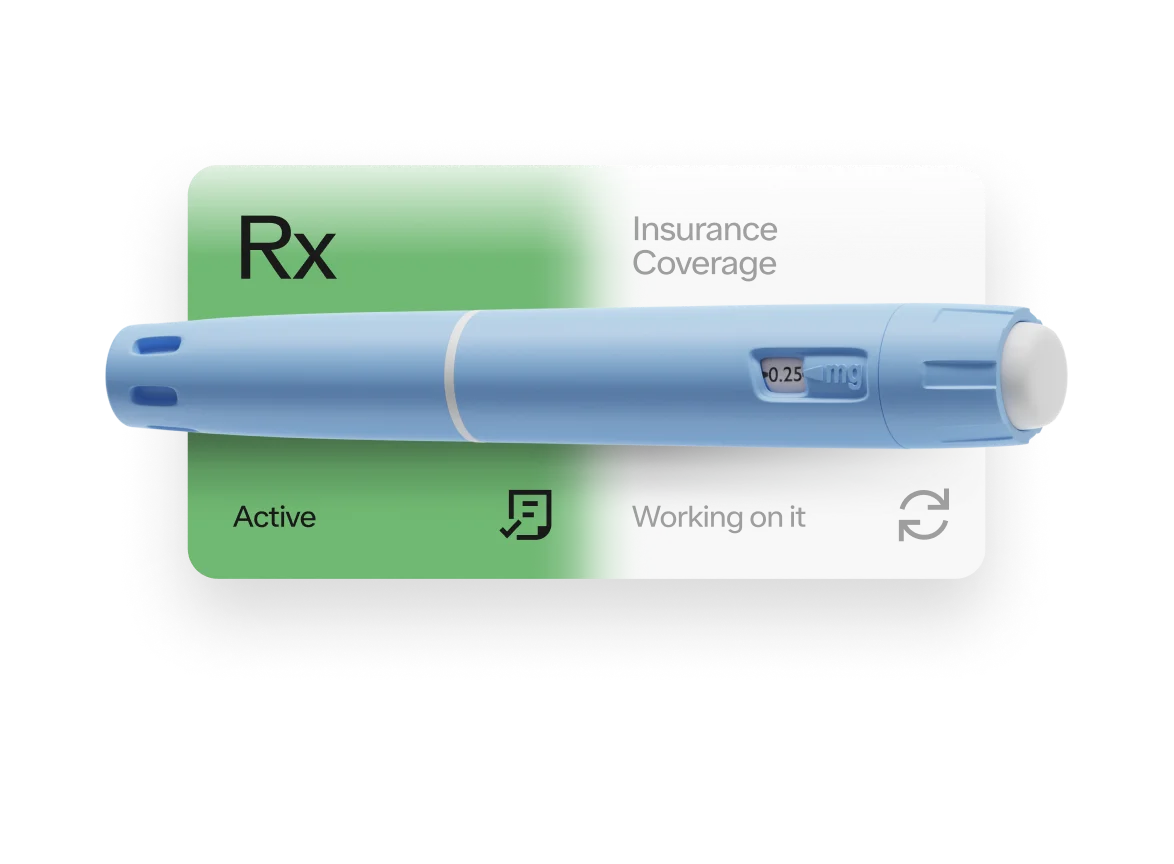Key takeaways
Muscle and joint pain are not considered common side effects of Ozempic, but some people report experiencing them on the drug.
Muscle pain on Ozempic may be explained by another cause, such as an injection site reaction, dehydration, or soreness from exercise.
Joint pain on Ozempic may be the result of an underlying health condition or certain medications.
Here's what we'll cover
Here's what we'll cover
Key takeaways
Muscle and joint pain are not considered common side effects of Ozempic, but some people report experiencing them on the drug.
Muscle pain on Ozempic may be explained by another cause, such as an injection site reaction, dehydration, or soreness from exercise.
Joint pain on Ozempic may be the result of an underlying health condition or certain medications.
Ozempic (semaglutide), the type 2 diabetes drug that can be prescribed off-label for weight loss, is known for a range of side effects, from abdominal pain to “Ozempic butt.” But what about muscle and joint pain? While they were not reported as side effects in clinical trials, a quick search on the Ozempic subreddit reveals dozens of posts from people who say they’ve experienced an uptick in muscle or joint pain since starting the prescription medication.
So, what’s the deal? Does Ozempic cause muscle and joint pain or not? The short answer: It’s unlikely. For the longer answer, including what could be behind the anecdotally reported aches and pains and what you can do about it, read on.
Ozempic Important Safety Information: Read more about serious warnings and safety info.
Can Ozempic cause muscle pain?
Muscle pain, or “myalgia” in medical parlance, is not a common side effect of Ozempic. In clinical trials of the drug, participants taking Ozempic—as well as those taking the placebo, for what it’s worth—did not report significant muscle pain. However, they did note back and joint pain. (Among these, fewer individuals reported joint pain than those on a placebo, and the percentage of people mentioning back pain was almost the same across Ozempic vs. a placebo.)
Ozempic works by mimicking a gut hormone called glucagon-like peptide-1 (GLP-1). In doing so, the medication slows digestion, regulates the release of insulin and glucose, and sends signals to your brain that you’re full—all of which can help keep blood sugar levels in check and lead to weight loss. Given the drug’s mechanisms of action, the majority of Ozempic’s side effects are digestive in nature, with the most common being nausea, vomiting, diarrhea, abdominal pain, and constipation. Other side effects can occur, but they are much rarer.
What could cause muscle pain on Ozempic?
While Ozempic is not known to cause muscle pain, that doesn’t mean that you can’t experience it while taking the drug. It just means that it may be more likely that your symptoms are due to another cause rather than directly linked to the medication. Some possible explanations for muscle pain on Ozempic include pain near the injection site, dehydration, and overzealous exercise.
Injection site pain
Ozempic is administered weekly via a subcutaneous (under the skin) injection in the abdomen, thigh, or upper arm. To minimize discomfort and allow the area to heal, it’s recommended to rotate through the injection sites and avoid injecting the medicine in the exact same place repeatedly.
Failing to switch up injection locations could be to blame for muscle pain on Ozempic. However, even with rotation, some people may be more likely to experience pain at the injection site than others. Repeatedly injecting in the same place can cause a lump of fatty tissue to build up in that spot, which can lead to pain and may even affect the absorption of the medication. In clinical trials, between 0.2% and 1.2% of people reported injection site reactions (discomfort or rash).
Dehydration
Some of Ozempic’s side effects—namely, nausea, diarrhea, and vomiting—can cause dehydration. This can also happen due to GLP-1’s potential effect on the body’s ability to sense thirst. Dehydration, in turn, can cause symptoms like darker urine, thirst, headache, and muscle cramps—the latter of which may be to blame for muscle pain on Ozempic.
If you are experiencing the aforementioned GI side effects (especially vomiting and diarrhea) and not adequately replenishing your fluids, you are increasing your chances of experiencing dehydration and, in turn, muscle cramps and, in turn, muscle pain on Ozempic. The solution here is super simple: Make sure to hydrate. You can do this by upping your intake of water (which, BTW, may further help with weight loss), sucking on ice cubes, and drinking electrolyte-rich beverages.
Exercise
Whether you are taking Ozempic for type 2 diabetes or off-label for weight loss, the drug is meant to be used in combination with lifestyle changes such as diet and exercise. If you are new to working out or have recently upped the intensity of your routine, you may experience aches and pains that are typically the result of increased physical activity. The good news? The soreness, which is known as delayed onset muscle soreness (DOMS), should subside as the muscles recover and become stronger over time.
That said, it’s also possible that any muscle pain on Ozempic may be from an injury sustained during exercise. Research suggests that people with higher body weights may be more vulnerable to injury while working out and that obesity can make these injuries feel worse. A personal trainer or physical therapist can help you design a workout routine that includes adequate warm-up and cool-down exercises, as well as a gradual buildup in intensity, so you can reduce your risk of getting injured.
Can Ozempic cause joint pain?
Similar to muscle pain, joint pain is not considered a common side effect of Ozempic. In fact, in one clinical trial, joint pain, technically known as “arthralgia,” was actually less common among the people taking Ozempic than those taking a placebo. Around 4–5% of people taking Ozempic reported “arthralgia,” or joint pain, compared with 6.5% of those taking a placebo. Back pain was reported as a separate side effect, but even that was essentially equal between Ozempic and placebo.
This trend seems to hold true for Wegovy, which contains the same active ingredient as Ozempic (semaglutide) but in higher dosage strengths. In clinical trials of Wegovy, people taking a placebo were more likely to report joint pain than those taking the drug, and the same held true for back pain as well.
Wegovy Important Safety Information: Read more about serious warnings and safety info.
What could cause joint pain on Ozempic?
Joint pain seems to be less common on Ozempic compared to placebo, at least according to clinical trials. So, if you’re experiencing joint pain on Ozempic, it’s possible it’s due to another reason, such as underlying health conditions or other medications you may be taking.
Underlying health conditions
Joint pain can be associated with certain health conditions, such as osteoarthritis and autoimmune disease. Osteoarthritis is a type of arthritis that commonly affects the joints in the hands, hips, and knees, resulting in joint pain. It also tends to overlap with both obesity and type 2 diabetes—two conditions for which people may take Ozempic. For example, individuals with type 2 diabetes are about twice as likely to have arthritis. Furthermore, obesity is a risk factor for both type 2 diabetes and arthritis.
While osteoarthritis is common, it is not the only potential cause of joint pain. Other conditions associated with joint pain include:
Lupus
Bursitis
Gout
Tendinitis
Infection
Injury
If you are experiencing joint pain on Ozempic, it could be a warning sign of an underlying health issue, and it might be a coincidence that you are noticing it now while taking Ozempic. A healthcare provider is best equipped to determine whether an underlying illness may be to blame for your symptoms and how to best treat it. And on that note, it’s important to remember that it’s always a good idea to consult a healthcare provider if you’re experiencing symptoms you didn’t expect—such as muscle and joint pain—on Ozempic.
Medications
Certain medications, including other drugs that also treat type 2 diabetes, are known to cause joint pain. For example, some DPP-4 inhibitors, such as Januvia (sitagliptin), have been associated with severe joint pain (as well as muscle pain). Statins, which are typically taken to improve cholesterol, can also cause joint pain or achiness. If you are experiencing joint or muscle pain, tell your healthcare provider; they may need to check blood tests and potentially discontinue culprit medications.
What to do if you experience muscle and joint pain on Ozempic?
If you are experiencing muscle or joint pain on Ozempic (or both), make an appointment with your healthcare provider. They can help you understand what’s causing your symptoms and recommend a treatment plan—whether that involves treating an underlying condition, adjusting your medications, or continuing to lose weight.
How to treat muscle and joint pain on Ozempic
If you are experiencing muscle or joint pain on Ozempic (or both), make an appointment with your healthcare provider. They can help you understand what’s causing your symptoms and recommend a treatment plan, which typically depends on what’s to blame for your pain. If an underlying condition is causing your pain, treating that condition may offer relief. If you are taking a medication known to cause joint pain, such as a DPP-4 inhibitor, your healthcare provider may want to adjust your dosage or switch you to another medication.
In some cases, continuing treatment with Ozempic may be the best path forward. Taking Ozempic as directed—which includes keeping up with exercise and following a healthy (often low-calorie) diet—can lead to weight loss and increased muscle strength, both of which can relieve muscle and joint pain. Weight loss can relieve the pressure on the joints, while exercise can help build up the muscles around them, providing further relief. Losing fat mass, in particular, may relieve muscle and joint pain, as body fat is linked with increased joint pain in the back, knee, and foot.
Studies of people with knee osteoarthritis have found that those who lose at least 10% of their body weight experience significant pain relief and improved functioning. Moreover, research shows that people who lose weight by eating better and moving their bodies more—rather than just focusing on one or the other—experience the greatest pain relief. And you don’t have to wait until you make a lot of progress to experience muscle pain relief. In fact, it can start with earlier weight loss milestones, with those who lose at least 5% of their body weight experiencing pain relief.
Bottom line
If you’re experiencing joint or muscle pain while taking Ozempic, it’s likely not due to the drug itself. But it’s still worth bringing up to your healthcare provider. They can help you determine what’s actually behind the symptoms and help you navigate a treatment plan to achieve relief.
DISCLAIMER
If you have any medical questions or concerns, please talk to your healthcare provider. The articles on Health Guide are underpinned by peer-reviewed research and information drawn from medical societies and governmental agencies. However, they are not a substitute for professional medical advice, diagnosis, or treatment.
Canadian Agency for Drugs and Technologies in Health. (2019). Clinical Review Report: Semaglutide (Ozempic): (Novo Nordisk Canada Inc.): Indication: For the treatment of adult patients with type 2 diabetes mellitus to improve glycemic control, in combination with metformin (second-line treatment), and in combination with metformin and sulfonylurea (third-line treatment). Retrieved from https://www.ncbi.nlm.nih.gov/books/NBK544016/
Dunlevy, C., MacLellan, G. A., O'Malley, E., et al. (2019). Does changing weight change pain? Retrospective data analysis from a national multidisciplinary weight management service. European Journal of Pain (London, England), 23(8), 1403–1415. doi: 10.1002/ejp.1397. Retrieved from https://pubmed.ncbi.nlm.nih.gov/30963658/
Gilbert, M. P. & Pratley, R. E. (2020). GLP-1 Analogs and DPP-4 Inhibitors in Type 2 Diabetes Therapy: Review of Head-to-Head Clinical Trials. Frontiers in Endocrinology, 11, 178. doi: 10.3389/fendo.2020.00178. Retrieved from https://www.ncbi.nlm.nih.gov/pmc/articles/PMC7145895/
Hirsch, L. J. & Strauss, K. W. (2019). The Injection Technique Factor: What You Don't Know or Teach Can Make a Difference. Clinical Diabetes: A Publication of the American Diabetes Association, 37(3), 227–233. doi: 10.2337/cd18-0076. Retrieved from https://pmc.ncbi.nlm.nih.gov/articles/PMC6640874/
Kim, J. & Yoon, J. H. (2021). Does Obesity Affect the Severity of Exercise-Induced Muscle Injury?. Journal of Obesity & Metabolic Syndrome, 30(2), 132–140. doi: 10.7570/jomes20100. Retrieved from https://www.ncbi.nlm.nih.gov/pmc/articles/PMC8277587/
MedlinePlus. (2023). Dehydration. Retrieved from https://medlineplus.gov/ency/article/000982.htm
MedlinePlus-a. (2024). How to take statins. Retrieved from https://medlineplus.gov/ency/patientinstructions/000748.htm
MedlinePlus-b. (2024). Joint pain. Retrieved from https://medlineplus.gov/ency/article/003261.htm
Messier-, S. P., Mihalko, S. L., Legault, C., et al. (2013). Effects of intensive diet and exercise on knee joint loads, inflammation, and clinical outcomes among overweight and obese adults with knee osteoarthritis: the IDEA randomized clinical trial. JAMA, 310(12), 1263–1273. doi: 10.1001/jama.2013.277669. Retrieved from https://pubmed.ncbi.nlm.nih.gov/24065013/
Nakhleh, A., Shehadeh, N., & Mansour, B. (2024). GLP-1 receptor agonists may enhance the effects of desmopressin in individuals with AVP deficiency: a case series and proposed mechanism. Pituitary, 27(5), 731–736. doi: 10.1007/s11102-024-01451-7. Retrieved from https://pubmed.ncbi.nlm.nih.gov/39240512/
Okifuji, A. & Hare, B. D. (2015). The association between chronic pain and obesity. Journal of Pain Research, 8, 399–408. doi: 10.2147/JPR.S55598. Retrieved from https://www.ncbi.nlm.nih.gov/pmc/articles/PMC4508090/
Piva, S. R., Susko, A. M., Khoja, S. S., et al. (2015). Links between osteoarthritis and diabetes: implications for management from a physical activity perspective. Clinics in Geriatric Medicine, 31(1), 67–viii. doi: 10.1016/j.cger.2014.08.019. Retrieved from https://www.ncbi.nlm.nih.gov/pmc/articles/PMC4254543/
Riddle, D. L. & Stratford, P. W. (2013). Body weight changes and corresponding changes in pain and function in persons with symptomatic knee osteoarthritis: a cohort study. Arthritis Care & Research, 65(1), 15–22. doi: 10.1002/acr.21692. Retrieved from https://www.ncbi.nlm.nih.gov/pmc/articles/PMC3401342/
Rubino, D., Abrahamsson, N., Davies, M., et al. (2021). Effect of Continued Weekly Subcutaneous Semaglutide vs Placebo on Weight Loss Maintenance in Adults With Overweight or Obesity: The STEP 4 Randomized Clinical Trial. JAMA, 325(14), 1414–1425. doi: 10.1001/jama.2021.3224. Retrieved from https://www.ncbi.nlm.nih.gov/pmc/articles/PMC7988425/
Rubino, D. M., Greenway, F. L., Khalid, U., et al. (2022). Effect of Weekly Subcutaneous Semaglutide vs Daily Liraglutide on Body Weight in Adults With Overweight or Obesity Without Diabetes: The STEP 8 Randomized Clinical Trial. JAMA, 327(2), 138–150. doi: 10.1001/jama.2021.23619. Retrieved from https://www.ncbi.nlm.nih.gov/pmc/articles/PMC8753508/
US Food & Drug Administration (FDA). (2023). Highlights of Prescribing Information: Ozempic (semaglutide) injection, for subcutaneous use. Retrieved from https://www.accessdata.fda.gov/drugsatfda_docs/label/2023/209637s020s021lbl.pdf
Veronese, N., Cooper, C., Reginster, J. Y., et al. (2019). Type 2 diabetes mellitus and osteoarthritis. Seminars in Arthritis and Rheumatism, 49(1), 9–19. doi: 10.1016/j.semarthrit.2019.01.005. Retrieved from https://www.ncbi.nlm.nih.gov/pmc/articles/PMC6642878/
Walsh, T. P., Arnold, J. B., Evans, A. M., et al. (2018). The association between body fat and musculoskeletal pain: a systematic review and meta-analysis. BMC Musculoskeletal Disorders, 19(1), 233. doi: 10.1186/s12891-018-2137-0. Retrieved from https://www.ncbi.nlm.nih.gov/pmc/articles/PMC6052598/
Weiss, E. P., Jordan, R. C., Frese, E. M., et al. (2017). Effects of Weight Loss on Lean Mass, Strength, Bone, and Aerobic Capacity. Medicine and Science in Sports and Exercise, 49(1), 206–217. doi: 10.1249/MSS.0000000000001074. Retrieved from https://www.ncbi.nlm.nih.gov/pmc/articles/PMC5161655/













